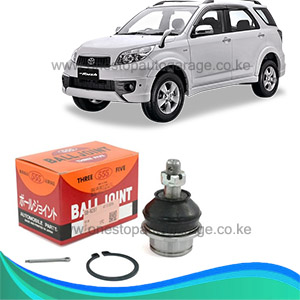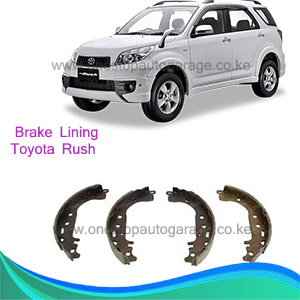-22%
Get Toyota Rush J200E Front Stabilizer Link Assy 0123-J200F in Kenya
The Front Stabilizer Link Assembly, also known as the sway bar link, is a crucial component of a vehicle’s suspension system. It connects the stabilizer bar (sway bar) to the control arms or suspension struts, helping to reduce body roll during cornering and keeping the car stable.
A well-functioning front stabilizer link ensures better handling, improved traction, and a safer driving experience. When worn out or damaged, it can lead to clunking noises, poor handling, and uneven tire wear.
In this guide, we’ll cover how the front stabilizer link works, its importance, types, symptoms of failure, replacement, and maintenance tips.
What is a Front Stabilizer Link Assembly? 🛠️
The Front Stabilizer Link Assembly consists of:
✔️ Metal Rod (or Ball Jointed Linkage) – Connects the sway bar to the suspension.
✔️ Ball Joints or Bushings – Allow flexibility and movement.
✔️ Bolts & Fasteners – Secure the link in place.
The stabilizer bar (sway bar) is a metal bar that runs across the front of the car, linking the left and right suspension systems. The stabilizer link connects this bar to the control arms or struts, allowing it to function properly.
How Does a Front Stabilizer Link Work? ⚙️🔄
The stabilizer link works in conjunction with the sway bar to enhance vehicle stability by:
1️⃣ Reducing Body Roll in Turns 🚗💨
When you turn a corner, weight shifts to one side. The stabilizer bar resists this movement by transferring force from one side of the suspension to the other, keeping the vehicle level.
2️⃣ Enhancing Road Grip & Stability 🏁
By keeping the suspension balanced, the stabilizer link ensures maximum tire contact with the road, improving traction and handling.
3️⃣ Providing a Smooth Ride 🔄
The link absorbs minor shocks and vibrations, preventing excessive movement and discomfort.
Without a functioning stabilizer link, the car would experience excessive body roll, poor handling, and reduced safety.
Types of Front Stabilizer Links 🚙
There are different types of stabilizer links, depending on design and construction:
1️⃣ Standard Stabilizer Links 🔩
✔️ Basic metal rod with ball joints or bushings.
✔️ Common in most passenger cars.
2️⃣ Heavy-Duty Stabilizer Links 🏁
✔️ Reinforced design for trucks & SUVs.
✔️ Withstands heavier loads & rough terrain.
3️⃣ Adjustable Stabilizer Links ⚙️
✔️ Allows drivers to fine-tune suspension settings.
✔️ Used in performance & off-road vehicles.
4️⃣ Polyurethane-Bushed Stabilizer Links 🔄
✔️ Stronger & more durable than rubber bushings.
✔️ Reduces play & improves suspension response.
Choosing the right stabilizer link depends on your vehicle type, driving style, and road conditions.
Symptoms of a Failing Front Stabilizer Link 🚨⚠️
A worn-out or damaged front stabilizer link can cause serious handling issues. Here are key warning signs:
1️⃣ Clunking or Rattling Noises 🔊
✔️ If you hear a clunking noise when driving over bumps or turning, the stabilizer link is likely loose or worn out.
2️⃣ Excessive Body Roll in Turns 🚗
✔️ If the car leans more than usual when cornering, the stabilizer link isn’t keeping the suspension balanced.
3️⃣ Loose or Unstable Steering ⚠️
✔️ A failing stabilizer link reduces control, making the steering feel sloppy or unresponsive.
4️⃣ Uneven or Premature Tire Wear 🔄
✔️ Worn links can affect alignment and suspension balance, leading to irregular tire wear.
5️⃣ Vibrations in the Steering Wheel 🔧
✔️ A bad stabilizer link can cause the steering wheel to shake or vibrate, especially on rough roads.
Ignoring these symptoms can lead to further suspension damage and compromise safety.
When to Replace a Front Stabilizer Link? 🔄🛠️
🔹 Every 50,000 – 80,000 km (30,000 – 50,000 miles) under normal conditions.
🔹 Earlier if driving on rough roads or carrying heavy loads.
🔹 Immediately if you notice clunking, loose steering, or excessive body roll.
How to Replace a Front Stabilizer Link? 🔧
Tools Needed:
✅ Socket Wrench Set 🔩
✅ Jack & Jack Stands 🔺
✅ Penetrating Oil (for rusty bolts) 🛠️
✅ Torque Wrench ⚙️
✅ New Front Stabilizer Link 🆕
Step-by-Step Guide:
1️⃣ Park the Vehicle & Secure It 🅿️
Engage the parking brake and use wheel chocks.
2️⃣ Lift the Front End 🔧
Use a jack to raise the front of the car and secure it with jack stands.
3️⃣ Locate & Remove the Old Stabilizer Link 🚗
✔️ Spray penetrating oil on the bolts if they’re rusted.
✔️ Use a wrench to loosen & remove the bolts from both ends.
4️⃣ Install the New Stabilizer Link 🆕
✔️ Align the new link in place.
✔️ Tighten bolts to manufacturer torque specs.
5️⃣ Lower the Vehicle & Test Drive 🚙
✔️ Check for improved stability and noise reduction.
How to Maintain Front Stabilizer Links? 🏁
✔️ Inspect Suspension Every 20,000 km – Look for wear & loose bolts.
✔️ Check for Unusual Noises – Clunks = time for inspection.
✔️ Lubricate Ball Joints (If Applicable) – Prevents premature wear.
✔️ Avoid Rough Roads & Potholes – Reduces impact damage.
✔️ Replace in Pairs – Ensures even performance on both sides.
Conclusion: Why Front Stabilizer Links Matter 🚗💨
The Front Stabilizer Link Assembly is essential for smooth handling, stability, and safety. A worn-out link can cause clunking noises, poor steering response, and excessive body roll.
Follow us on Facebook for more parts.




Reviews
Clear filtersThere are no reviews yet.